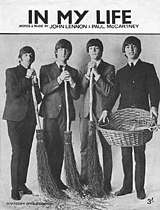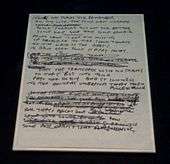In My Life
"In My Life" is a song by the English rock band the Beatles from their 1965 album Rubber Soul. It was written by John Lennon and Paul McCartney, who later disagreed over the extent of their respective contributions to the song. Lennon credited the harmony and bridge to McCartney, while McCartney claimed the entire musical structure. George Martin contributed the piano solo bridge, which was sped up to sound like a harpsichord.
| "In My Life" | |
|---|---|
 Cover of the Northern Songs sheet music | |
| Song by the Beatles | |
| from the album Rubber Soul | |
| Released | 3 December 1965 |
| Recorded | 18 & 22 October 1965 |
| Studio | EMI, London |
| Genre | |
| Length | 2:28 |
| Label | Parlophone |
| Songwriter(s) | Lennon–McCartney |
| Producer(s) | George Martin |
| Audio sample | |
| |
According to Lennon, "In My Life" was his "first real major piece of work" because it was the first time he penned personal lyrics about his own life. The original version of the lyrics was based on a bus route he used to take in Liverpool, naming various sites seen along the way, including Penny Lane and Strawberry Field. Lennon discarded this lyrical idea in favour of a more generalized meditation on his past. He and McCartney later revisited those original references with their respective songs "Strawberry Fields Forever" and "Penny Lane".
"In My Life" inspired more pop music producers to use harpsichords in their arrangements.[3] Rolling Stone magazine ranked "In My Life" number 23 on its list of "The 500 Greatest Songs of All Time", as well as fifth on their list of the Beatles' "100 Greatest Songs".[4][5] The song placed second on CBC's 50 Tracks. Mojo magazine named it the best song of all time in 2000.[6] According to Acclaimed Music, it is the 160th most celebrated song in popular music history.[7]
Lyrics

In a 1980 interview, Lennon referred to this song as his "first real major piece of work" because it was the first time he penned personal lyrics about his own life.[8] According to Lennon, the song's origins can be traced to when the English journalist Kenneth Allsop made a remark that Lennon should write songs about his childhood.[9] Afterwards, Lennon wrote a song in the form of a long poem reminiscing on his childhood years. The original version of the lyrics was based on a bus route he used to take in Liverpool, naming various sites seen along the way, including Penny Lane and Strawberry Field.[10][11]
Lennon later thought the original lyrics were "ridiculous", calling it "the most boring sort of 'What I Did On My Holidays Bus Trip' song". He reworked the words and replaced the specific memories with a generalized meditation on his past.[11] "Very few lines" of the original version remained in the finished song.[10] According to Lennon's friend and biographer Peter Shotton, the lines "Some [friends] are dead and some are living/In my life I've loved them all" referred to himself and Stuart Sutcliffe (who died in 1962).[9]
Musical authorship

Regarding composition of the music, Lennon's and McCartney's recollections differ. Referring to McCartney, Lennon said "his contribution melodically was the harmony and the middle-eight itself."[11] In 1977, when shown a list of songs Lennon claimed writing on for the magazine Hit Parader, the only entry McCartney disputed was "In My Life".[12] McCartney said he set Lennon's lyrics to music from beginning to end, taking inspiration for the melody from songs by Smokey Robinson & the Miracles.[13][14] In 1976, he commented: "I liked 'In My Life'. Those were words that John wrote, and I wrote the tune to it. That was a great one."[15]
A 2018 study that used bag-of-words modelling, conducted by artificial intelligence researchers at Harvard University, reported that there was a .018% probability of McCartney writing the entire song.[16] Lennon was given an 81.1% certainty of writing the verses, while McCartney was given a 43.6% certainty of writing the bridge.[17] The analysts stated:
[There's] a large amount of uncertainty about the latter. [...] The bridge having a probability that McCartney wrote the song closer to 0.5 may be indicative of their collaborative nature, as suggested by Lennon, of this part of the song. [...] [The melody] may in fact have been written by McCartney who stated he composed the song in the style of Smokey Robinson and the Miracles, but actually wrote in the style of Lennon, whether consciously or subconsciously.[18]
Recording
The song was recorded on 18 October 1965, and was complete except for the instrumental bridge.[19] At that time, Lennon had not decided what instrument to use, but he subsequently asked George Martin to play a piano solo, suggesting "something Baroque-sounding".[2] Martin wrote a Bach-influenced piece that he found he could not play at the song's tempo. On 22 October, the solo was recorded with the tape running at half speed, so when played back at normal pace the piano was twice as fast and an octave higher, solving the performance challenge and also giving the solo a unique timbre, reminiscent of a harpsichord.[10][19]
Personnel
- John Lennon – double-tracked vocal, rhythm guitar
- Paul McCartney – harmony vocal, bass
- George Harrison – harmony vocal, lead guitar
- Ringo Starr – drums
- George Martin – piano, tambourine
- unknown – bells (possibly Starr)
Certifications
| Region | Certification | Certified units/sales |
|---|---|---|
| United Kingdom (BPI)[21] | Silver | 200,000 |
|
*sales figures based on certification alone | ||
Notable cover versions
- Siw Malmkvist recorded in Swedish, "I mitt liv" (1970) on her album Underbara Siw (Wonderful Siw), which was awarded a Swedish Grammis the same year.
- George Harrison did a soul-arranged version during his Dark Horse North American tour.
- Bette Midler recorded a version that was released as a single in early 1992 from the soundtrack of her movie For the Boys, It peaked at #20 on the Billboard Adult Contemporary chart in the U.S. This version later appeared on her 1993 hits album Experience the Divine: Greatest Hits. It was also used as background music for a tribute to NASCAR on ABC at the end of the 2000 Brickyard 400 which was the final broadcast of NASCAR on ABC until 2007.[22]
- George Martin produced a version on his 1998 album In My Life, narrated by Sean Connery.
- In 2012, Lennon's first wife, Cynthia, recorded the song to mark her 72nd birthday and for The Beatles Complete on Ukulele, an ongoing project to cover every Beatles song on (or at least including) a ukelele.[23][24]
References
- Doyle Greene (10 March 2014). The Rock Cover Song: Culture, History, Politics. McFarland. pp. 161–. ISBN 978-1-4766-1507-3.
- Hertsgaard, Mark (1996). A Day in the Life: The Music and Artistry of the Beatles. New York: Delacorte Press. p. 156. ISBN 0-385-31517-1.CS1 maint: ref=harv (link)
- Myers, Marc (30 October 2013). "Bach & Roll: How the Unsexy Harpsichord Got Hip". The Wall Street Journal.
- "The Rolling Stone 100 Greatest Beatles Songs". Rolling Stone. August 2010. Retrieved 30 August 2010.
- "5. In My Life". 100 Greatest Beatles Songs. Rolling Stone. Retrieved 21 May 2013.
- "Mojo lists". Rocklistmusic. Retrieved 21 April 2017.
- "In My Life ranked 160th most celebrated song". Acclaimed Music. Retrieved 15 July 2018.
- Sheff, David (2010). All We Are Saying: The Last Major Interview with John Lennon and Yoko Ono. United States: St. Martin's Press. p. 178. ISBN 9781429958080. Retrieved 14 June 2020.
- Everett, Walter (2001). The Beatles as Musicians: The Quarrymen Through Rubber Soul. Oxford: Oxford Press. p. 319. ISBN 0-19-514105-9.CS1 maint: ref=harv (link)
- Spitz, Bob (2005). The Beatles: The Biography. New York: Little, Brown and Company. pp. 587–91. ISBN 1-84513-160-6.CS1 maint: ref=harv (link)
- Sheff, David (2000). All We Are Saying. New York: St. Martin's Press. pp. 152, 178. ISBN 0-312-25464-4.CS1 maint: ref=harv (link)
- "Lennon–McCartney Songalog: Who Wrote What" (PDF). Hit Parader. Vol. Winter 1977 [reprint of April 1972] no. 101. pp. 38–41. Retrieved 6 June 2017.
- Miles, Barry (1997). Paul McCartney: Many Years from Now. New York: Macmillan. p. 277. ISBN 0-7493-8658-4.CS1 maint: ref=harv (link)
- Compton, Todd (2017). Who Wrote the Beatle Songs? A History of Lennon-McCartney. San Jose: Pahreah Press. p. 130-132. ISBN 978-0-9988997-0-1.CS1 maint: ref=harv (link)
- Gambaccini, Paul, ed. (1976). Paul McCartney in His Own Words. New York: Flash. p. 19. ISBN 0-8256-3910-7.CS1 maint: ref=harv (link)
- Simon, Scott; Wharton, Ned (11 August 2018). "A Songwriting Mystery Solved: Math Proves John Lennon Wrote 'In My Life'". NPR.org. Retrieved 13 August 2018.
- Matthews-King, Alex (6 July 2019). "AI used to solve disputed songwriting credits of Beatles hits". The Independent. Retrieved 10 May 2020.
- "(A) Data in the Life: Authorship Attribution in Lennon-McCartney Songs by Mark Glickman, Jason Brown, and Ryan Song". 22 June 2019.
- Lewisohn, Mark (1988). The Beatles Recording Sessions. New York: Harmony Books. pp. 64–5. ISBN 0-517-57066-1.CS1 maint: ref=harv (link)
- MacDonald, Ian (2005). Revolution in the Head: The Beatles' Records and the Sixties (Second Revised ed.). London: Pimlico (Rand). p. 169. ISBN 1-84413-828-3.CS1 maint: ref=harv (link)
- "British single certifications – The Beatles – In My Life". British Phonographic Industry. Retrieved 19 July 2019. Select singles in the Format field. Select Silver in the Certification field. Type In My Life in the "Search BPI Awards" field and then press Enter.
- "For the Boys - Bette Midler : Awards". AllMusic. 12 November 1991. Retrieved 1 July 2012.
- Padgett, Ray (27 January 2012). "Cynthia Lennon (John's Wife) Covers the Beatles' "In My Life"". Cover Me. Retrieved 24 August 2019.
- "John Lennon's Ex-Wife Cynthia Lovingly Remembers Him With Tender "In My Life" Cover". Society of Rock. Retrieved 24 August 2019.
External links
| Wikiquote has quotations related to: Rubber Soul |